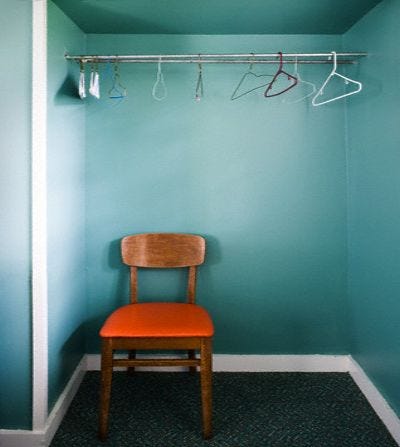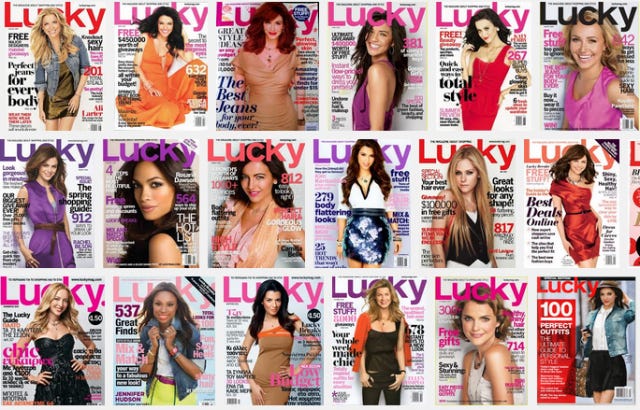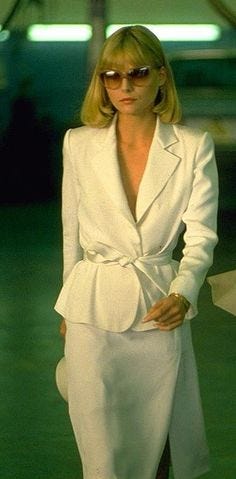So What, Who Cares (vol 2, issue 82) How radically the retail landscape is shifting right now
Hello! I've been poking around my calendar and do y'all realize, So What, Who Cares? is going to turn one in just two months? If it were a child, I'd be booking a bounce house right about now and patting myself on the back for planning ahead. But it's a newsletter -- how should we celebrate the birthday? Yes, we. I wouldn't be doing this without y'all. Send me your best birthday ideas for an email newsletter via Twitter or email.
*

Holy cats, but I wasn't kidding when I said that American retail news was going to be the gift that kept on giving to disaster junkies this year (vol 2, issue 78). In the scant eight days since I posted that issue, the Gap announced plans to close more than a quarter of their U.S. retail outlets, while J. Crew fired its lead womenswear designer and laid off 10% of its corporate staff -- all, as Billfold pointed out -- because of a sweater and a pair of shoes.
So what? This is part of the ongoing collapse of the mid-tier retailer. J. Crew and Gap get a lot of ink because they're fun to watch -- Gap is basically the White Sox of retail at this point, as famous for failing to go all the way as they are for existing in the first place -- but it's not like midmarket stalwarts like Ann Taylor and Abercrombie and Fitch are doing that well, and the Children's Place had a good quarter only because they're aggressively closing stores and keeping a tight rein on expenses.
Who cares? The people who used to rely on the mid-market retailers to keep them clothed.

It is all fine and good to espouse minimalism and 33-item wardrobes and all if you have the kind of life where you can get by with a few pairs of pants and a tunic because the weather never really fluctuates -- and if you or the people you're responsible for clothing are always scrupulous with the handful of ethically-sourced garments you've carefully collected.
But for people who have to dress for four -- or six -- seasons, and for people who have to dress for a rich and varied life, and for people who have to dress children who grow quickly, a "slow fashion" wardrobe may be neither practical nor feasible.
And that's where mid-market retailers used to come in: For a little money, you could build a wardrobe that worked without breaking the bank, and you could dress your kids in clothes that could be handed down without wearing out. Fast fashion, with its shoddy garment construction and poor fabric quality, is good for quickly filling in holes in a wardrobe -- but just as quickly leaving that hole to be refilled again. It's Vime's Theory of Boots made manifest: Midrange families will spend more over the long run and end up with less. Maybe that's just the cost of living in a rapidly shifting economic climate. It's time for the reign of the discounters on one end and the artisanal specialists on the other.

Related: Lucky magazine -- which launched in 2000 and was credited with "inventing a genre" when it got Advertising Age's "Magazine of the Year" award in 2003, with a circulation of 1 million in its heyday -- is dying with a series of well-documented whimpers.
Way back in the olden days, it was hailed as an editorial example of friction-free capitalism, i.e. it basically helped people decide what to buy, then pointed them in the direction of where to get it. Now, in an era where Pinterest, Instagram and Facebook are trying to make friction-free commerce so smooth as to leave skidmarks on your credit card statement, the notion of a print magazine that tells you what to buy doesn't connect with shoppers nearly so well as social recommendations do.
*

Your pop culture moment of the day: I haven't yet seen Jurassic World -- and I desperately want to -- but I found these articles on Bryce Dallas Howard's character worth chewing over: the Vulture essay that opens with a meticulous recitation of the lead female's wardrobe and high heels, noting how the outfit serves to broadcast that this is a woman in desperate need of being taken in hand by a real man, and the Racked essay that points out how even in movie criticism, working executive women wearing a meeting-appropriate outfit can't catch a break.

These two essays reminded me of one of my favorite classic books on costuming and wardrobe, Alison Lurie's The Language of Clothes, which is a reference primer deconstructing everything from the semiotics of polka dots to the significance of appropriating other cultures' costumes. They also reminded me of the Dara Laine You Tube sketch, "Deleted Scenes of Women in Disaster Movies Written by Men," which features women explaining how they like fighting vampires in high heels.
Also -- and this is totally on me -- please tell me I'm not the only one who thinks that Bryce Dallas Howard is working the Elvira Hancock look from Scarface. Yes? No? Your thoughts via Twitter or email.
*
Are there typos? I apologize in advance. The only editing class I did not get an A in was copyediting.
Did you miss an issue of So What, Who Cares? The archive is here. If you really like So What, Who Cares?, tell a friend to subscribe. And do not hesitate to hit me up via email or on Twitter. Thanks for reading!

